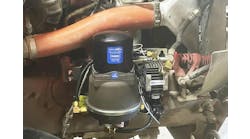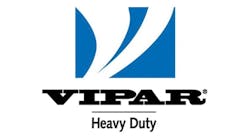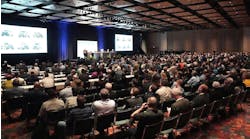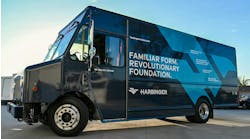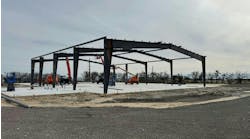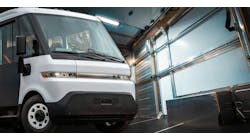Axle alignment critical to set wheels and tires in optimum position; TMC manual and educated technicians can help
AXLE alignment is necessary to set the wheels and tires in the optimum position for maximum tire performance, according to Rick Martin, Meritor LLC's training manager for North America.
“Axles are aligned in a static position so that when the vehicle is operating dynamically, the wheels and tires are in an optimum position with the road surface,” he said. “That optimum position is whatever it takes to get best tire life and best traction.”
He said toe-in is when wheels are closer together in the front than in the back, while toe-out is when the wheels are closer together in the back than in the front.
Toe is necessary to compensate for steering-component deflection.
“We set the toe at 1/16" because when you're going down the highway with the wheels toe-in, the road friction between the rubber and road is going to pull the tires out in a straight direction, which is steering deflection,” he said.
Steer-axle toe is adjustable to reduce wear to the leading edge of the tire and also to avoid road wander. Excessive toe-in wears the outside edge of tires, while excessive toe-out wears the inside edge of the tires.
“If have excessive toe in either direction, there's scrubbing of tires,” he said. “And as you lay a hand across the tire, you feel a knife edge going in one direction and smooth in the other direction. Toe is adjusted in a static condition so that the tires will run in a straight line under a dynamic condition.”
He said there are all kinds of specifications differences out there, so the Technology & Maintenance Council (TMC) has produced a manual of recommended practices on alignment, with a target value of 1/16" toe-in.
“Most tire wear is caused by incorrect toe settings,” Martin said. “The second-highest issue is axle-camber alignment. Toe adjustment is the responsibility of the vehicle manufacturer. The reason why is when we build axles in the parallelogram format, it has a beam across two steering arms. We set the toe at the plant.”
Martin said camber is the angle of the tire in relation to the ground. The goal is a positive camber, which occurs when the distance between the top of wheels is greater than the distance between the bottom of the wheels at ground level.
“A small amount of positive camber is built into the axle beam and knuckle by the axle manufacturer,” he said. “It's manufactured at positive ¼ degree. When it gets into a truck, it can be a positive or negative. When you think of a negative, you think that's going to be tire-wear issue. But a two-year study shows that camber is not one of biggest tire-wearing issues. Your toe and axle alignment are what you need to be looking at.
“TMC's target value is less than ¼ degree either side. You want to shoot for that. The camber angle is not adjustable. It is machined into both the axle beam and the knuckle. If you find that an axle beam is out of camber specs, you need to get us involved. In my 20 years with this company I've replaced three axle beams. Bending of axle beams is not recommended by axle manufacturers and will void the axle warranty.”
Martin said caster is the tilt of the kingpin center line when viewed from the side of the vehicle. The caster angle is the angle from the vertical position to the center line of the kingpin. If the top of the kingpin axis is toward the rear of the vehicle, the caster is positive.
A slight positive caster creates a self-aligning action that helps to stabilize the vehicle after turning and for driving straight ahead. Too much caster will increase steering effort or may amplify a shimmy condition.
He said the TMC target value is left +3½ degrees and right +4 degrees.
“They're talking about when you bring the vehicle in and do an alignment,” he said. “You try to set that alignment to that specific target value the best you can. We all agreed upon that and hopefully the industry can run with that. Caster is the responsibility of the vehicle manufacturer.”
When turning, the inner wheel must turn at a greater angle than the outer wheel, he said. It rotates in a smaller circle.
“At only one point in time during that turn do both tires really make a free-rolling state,” he said. “Every other time, they're scuffing.
“This angle is the turning radius angle, often called the Ackerman Angle. The angle is built into the design of the tie rod arms to give the best possible road contact and to minimize tire wear during turns. If the angle is not within specifications, premature tire wear will occur. The Ackerman angle is not adjustable. Hard parts must be replaced to set the proper angle for a particular OEM and wheelbase.”
Axle not perpendicular
He said that with tandem axle misalignment, you have skew and thrust. That means the axle is not perpendicular to the frame.
“When that axle not in there straight and parallel to the front steer axle, then you will have a push situation,” he said. “Then the driver has to compensate. When you have a tandem axle out of alignment and the driver has to turn the wheel in the other direction to compensate, you can actually get tire wear on the front steer tires that looks exactly like camber wear. You have to do a full vehicle alignment to see where the problem really lies. Most of the time, it's going to be tandem axle alignment.”
Scrub angle is formed by two thrust lines of a tandem axle vehicle (parallelism).
The thrust angle is an angle formed by the centerline of the vehicle frame and the direction that an axle points (square).
Irregular tire wear will appear on all wheel ends with tandems out of alignment, he said.
The TMC target value for scrub (parallelism) and thrust (square) is zero degrees.
“Both of them need to be perpendicular to the axle and parallel to one another,” he said. “And that's called a zero.”
Martin said it's not different on a trailer: Trailer alignment has to meet alignment specifications.
“When we build an axle housing for a drive axle, we do camber it and we do toe it,” he said. “That's the big axle housing under fifth wheel. There are no specifications in the field for checking that. We have engineering specifications.
“Trailer axle alignment is a function of three parameters: axle orientation, which is adjustable; axle camber, which is non-adjustable; and axle toe, which is non-adjustable. Our axle will come camber or non-camber, depending on the customer. It depends on where you're running. We've lost a lot of roads that had heavy crowns, and we have interstate highway systems, so even on a front-steer axle, we don't buy a front-steer axle camber any more. When it comes out of a facility's manufacturing plant, it's ¼-degree positive on both ends. We used to have bias for road crown.”
Martin said axle orientation is defined as the positioning of the axle assembly relative to the vehicle on which it is installed. On a single-axle vehicle, the axle is positioned relative to the vehicle. On a multiple-axle vehicle, the front axle is positioned relative to the vehicle, then the remaining axles are positioned so they are parallel to this axle.
“There are all different methods of doing this,” he said, “and they're all proven.”
- Forward-axle dimensions are measured from the kingpin to the axle centerline. If the measurement between “A” and “B” is greater than 1/8", the forward axle must be adjusted. If the measurement between “A” and “B” is less than 1/8", the forward axle does not require adjustment.
- Rear-axle dimensions are measured from the forward axle centerline to the rear axle centerline. If the measurement between “C” and “D” is greater than 1/16", the rear axle must be adjusted. If the measurement between “C” and “D” is less than 1/16", the rear axle does not require adjustment.
“You can't over-preload a wheel bearing or it will burn up in a quick time frame, so you have to have wheel bearing end play if you're doing a commissioned wheel bearing adjustment,” he said. “Maximum tapered roller bearing life is achieved at 0.001" preload. What's maximum life for you? You won't lose wheel seals. You won't get brake alignments coated with grease.”
A pre-alignment maintenance inspection check for condition and wear includes: cold tire pressure; Pitman arm for proper torque on steering box; draglink for wear; steering arm in the knuckle to make sure it's working properly; tie-rod ends.
“There are all kinds of ways to check them,” he said. “You can take four-, six-, eight-foot bar and jam it against the I-beam and push up on the cross tube and always get movement out of tie-rod assembles. That's because you're using enough pressure to compress the spring inside the ball joint.
“I've spent 43 years in this industry. I've been in both automotive and heavy truck, everywhere from mechanic to where I am now. Doctors practice every day, mechanics practice every day and learn every day. There's no way every one of us can answer all questions about everything technical. That's why there's supporting literature. That's why there are TMC Guidelines for Total Vehicle Alignment, with 45 pages of excellent information. It also has forms for doing tire checks and suspension tire wear recordkeeping.”
(To receive a manual, call 1-866-821-3468 or go to http://atabusinesssolutions.com.)
Martin listed the ride-complaint condition types: shimmy; harsh ride; handling; pitch/back slap; stability; bounce/hop; and vibration.
“There are two things I deal with at Meritor — shimmy and vibration,” he said. “Why? Because trucks are becoming more user-friendly. They want to be able to live in there and not feel anything on their butt — no shaking or rattling like trucks out there 40 to 50 years ago. There are Mercedes-Benz type vehicles, these Freightliners and Volvos. Shimmy most of time has to do with front steer tires.”
He said the Kent-Moore Electronic Vibration Analyzer (EVA) 2 is a low-cost electronic diagnostic tool to help diagnose low-frequency vibrations.
“It's a very high-tech, awesome product,” he said. “If you have shake, rattle, or roll that's vibratory from a rotating mass, it does not find loose suspension items — rotational items only.”
Trailer ride height
Tony Kockritz, Hendrickson International's regional service manager, said it's important to check trailer ride height, truck ride height, shock absorbers, and bushings.
“As regional service manager, I cover eight states and two Canadian provinces, and am in charge of training,” he said. “When I go to fleets, dealers, and repair shops, it's amazing what they don't know. That's something to know on any suspension.
“The ride height is the distance between the center line of the axle and the bottom of the sub-frame. If it's a slider box, it's the bottom of the box. If it's a regular trailer flatbed, it's going to be the bottom frame frail. The easiest way to measure is from that suspension-mounting surface to the top of the axle. And then once you figure out the diameter of the axle, just add the difference. If you have a five-inch diameter axle, take the tape measure and measure from the bottom of the sub-frame of the trailer and to the top of the axle. Take that dimension and add 2½ inches and get the trailer ride height. On all suspensions, there's a description tag that will tell you the ride height of that suspension.
“It's important that the ride height is set correctly because you want a maximum amount of jounce, which is up travel, and rebound, which is down travel in the suspension. If the ride height isn't set correctly, what can go wrong? We could have air-spring damage. Shock absorbers can get overextended. Trailer damage is the biggest one — the sub-frame.”
He said truck ride height is the same as for trailers, except that “entering from the bottom of the frame rail of the tractor and center line of the axle housing, right where the well is on the axle housing, is where you're measuring it to. On some tractors out there, they may have dual height valves. If they do, you have to do each side separately. The industry spec is plus or minus 1/8" of what the ride height is.”
